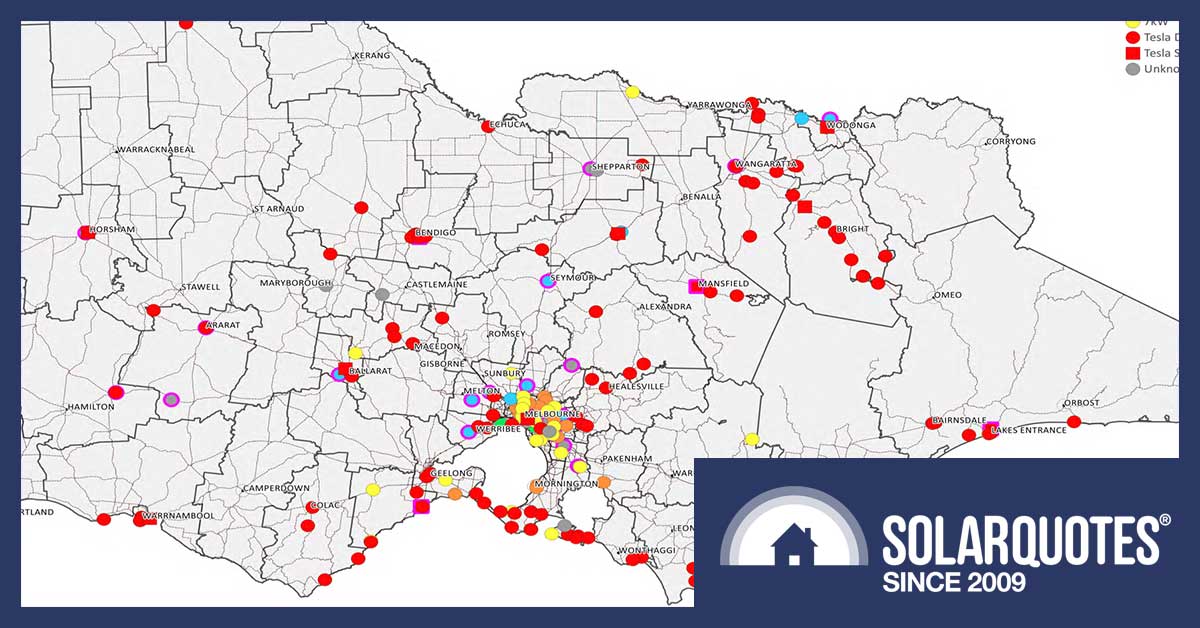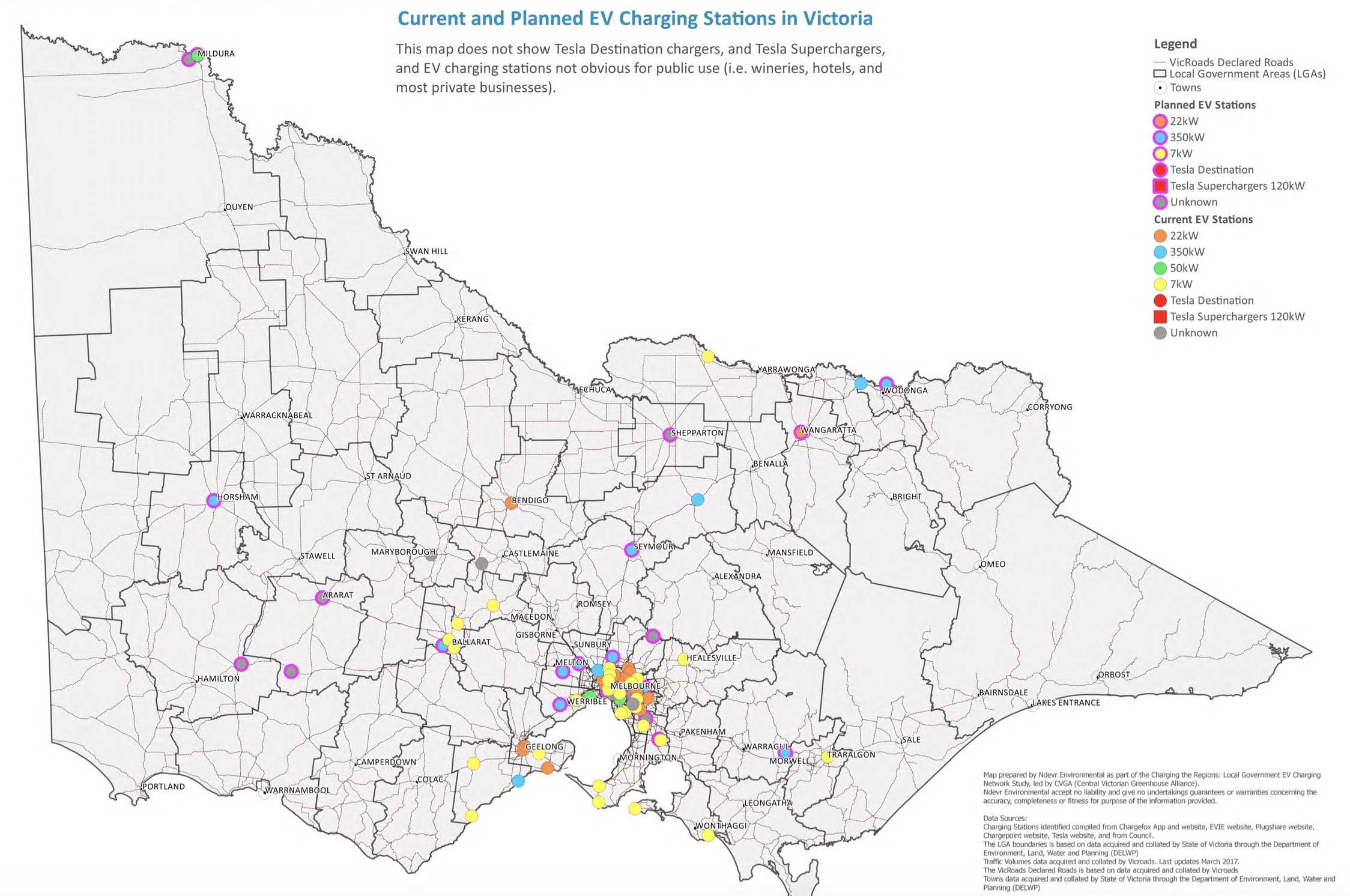
If you haven’t got a Tesla EV (red dots =. Tesla chargers) then your options to recharge across Victoria are limited.
Regional Victoria is awash with public EV charging stations if you happen to be a Tesla owner. An April report by the Central Victorian Greenhouse Alliance says if Tesla charging stations (only usable by cars of the same marque) are excluded from an assessment of that state’s charging infrastructure, EV drivers face coverage gaps away from the city.
The group of councils that produced the report wants to fix those gaps by finding ways to encourage the charging sector to roll out electric vehicle chargers of 25kW DC and higher capacity, and helping the chargers recover their costs with greater adoption of EVs by councils.
The “Charging the Regions” report reckons if the councils can find between $5 million and $7 million, they could get EV charger coverage in all 79 Victorian regional council areas.
Our Charging the Regions final report is now avail. For $5-7M a network of #electricvehicle fast chargers across all 79 Vic councils could boost regional tourism/eco dev, improve air quality, reduce oil reliance, lead on climate change… what a stimulus! https://t.co/zTxiyDaSrX
— CVGA (@CVGA_VIC) April 15, 2020
Right now, coverage falls well short of that aspiration if you’re don’t drive a Tesla electric vehicle. About a dozen regional council areas have no chargers (the report provides a map but not its data table, so apologies if I miscounted), and many of those currently part of the EV charging network only have one location.
As the map below shows, with Tesla excluded there are big gaps. Mildura, for example, is close to EV-isolated, since its nearest non-Tesla charger is more than 300km away, in Horsham. And for the moment, you can forget taking anything but a Tesla along the Great Ocean Road: charging infrastructure in the south-east ends at Traralgon.

Tesla chargers not shown.
The organisation has nominated 30 “Priority Towns”, where the CVGA wants fast-charging stations to be rolled out first: Ouyen, Swan Hill, Kerang, Echuca, Wycheproof, St Arnaud, Bendigo, Halls Gap, Castlemaine, Hamilton, Macedon, Portland, Warrnambool, Camperdown, Colac, Apollo Bay, Leongatha, Sale, Bairnsdale, Lakes Entrance, Orbost, Buchan Caves, Mallacoota, Yarrawonga, Benalla, Bright, Mansfield, Alexandria, Harrietville, and Omeo.
Considerations that influenced the choice of Priority Towns included:
“traffic volumes and regional connectivity; proximity to existing or planned charging station; population densities; proximity to popular tourist destinations; access to amenities; socio-economic areas; and planning zones”,
the report notes.
Can Victoria Get There from Here?
In the cost-benefit analyses the report includes, the reason for favouring 25kW DC chargers over the far cheaper 7kW single-phase AC chargers is clear. While all EVs on the Australian market can use 7kW chargers, people are more likely to be willing to pay for a fast charge. And while a driver’s “linger time” of more than two hours on a slow electric vehicle charger means they’ll most likely spend money as local tourists, people are more likely to stop where a fast charger is available.
The report identified the following issues as holding back the development of fast EV charging infrastructure in the Victorian regions:
- uncertainty regarding the role of local government;
- access to funds;
- confidence in the business case;
- uncertainty about site selection;
- concern about whether network infrastructure is available to power the charging stations;
- and a knowledge gap about the infrastructure needed for a network of EV charging stations.
None of these, however, seem to kill the case for a rollout.
7kW chargers are still viewed favourably in one context, by the way – as a charging mechanism for council fleets as they are electrified.
The process recommended in the report to get the electric vehicle charging stations installed is:
- To demonstrate councils’ commitment, sites should be proposed and the number of chargers for a site nominated;
- Distributors then vet the site proposals;
- Councils will issue EOIs to receive distributors’ proposals for the sites;
- After review, councils will issue RFQs for the EV charger rollout.
Related: Homeowner’s Guide To Solar Power And Electric Cars.

 RSS - Posts
RSS - Posts



Went to Walhalla recently. They have a charging station in the town. Not Telsla. But totally unusable as its also a parking area with no restrictions.
So if you wanted to charge your car you can’t. At least when i was there.
With my failing memory – please remind me…
Are the bulk of the Tesla-only chargers installed by 3rd parties such as a motel, shopping centre, Council? Or were they installed by Tesla (I don’t think so but)?
Tesla chargers are paid for by Tesla. I am pretty sure they use 3rd party installers.
The Tesla chargers you might be thinking of at motels and the like are ‘destination’ chargers, which are AC and usually work with any make of car. The ‘superchargers’ really are Tesla specific and are DC.
around 1 out of 3 tesla chargers are unable to charge my EV, I even know of 2 chargers together and neither will charge my EV, so to make a reliance on tesla charging stations charging a non tesla car \could leave you in strife, better to check the plugshare app first to see if other have been succesful in charging a non testa.
I agree that it is useful to check Plugshare to see if a Tesla destination charger has been used successfully with a non-Tesla. Checking in with Plugshare is doing others a favour. I have tried about 12 Tesla destination chargers with success with non-Tesla vehicles in each case but certainly I have heard of some that don’t work, presumably due to being set internally to Tesla-only rather than ‘legacy’ (ie promiscuous) mode.
Anything happening in NSW?
The NRMA are rolling out Rapid (50kW) charging stations in country towns.
Take a look at plugshare.com
Thanks Robert
Tesla charging stations (only usable by cars of the same marque)
What stupidity, that’s like the railway gauges all over again.
The above article is misleading as the 7kw destination chargers provided by Tesla to third parties eg Motels can be configured by a flick of a switch so they will charge many other electric vehicles now on the market with the now becoming standard ccs plug.
When I was in France a couple of years ago we stopped in a little village and there was a charging station that you plugged in to and swiped your credit card to pay for the charge. Is that what is occurring in Australia?
25kW DC fast charger is the only way to go forward for inter-city commuting. The 7kW AC snail charger is only for shopping centres to allow their customer to top up while shopping.
I agree with Eddy, if ever there was a case for the Government to step in and mandate the type of charging infrastructure and connection system this is it. At least where public money and land is being used, and sensibly, even when it’s not.